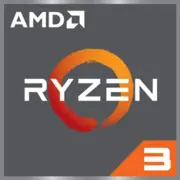AMD Ryzen 3 PRO 3300U

AMD Ryzen 3 PRO 3300U: Budget Processor for Work and Everyday Tasks
Analysis of capabilities, use cases, and comparisons as of April 2025
Architecture and Process Technology: Zen+ on 12nm
The AMD Ryzen 3 PRO 3300U processor, released in 2019, is based on the Zen+ microarchitecture and is manufactured using a 12nm process technology. This generation serves as a transitional phase between the original Zen and the more advanced Zen 2, improving energy efficiency and frequency potential.
- Cores and Threads: 4 cores and 4 threads. Unlike modern processors with hyper-threading (e.g., Ryzen 5 5500U), each physical core here handles only one thread.
- Clock Speeds: Base frequency is 2.1 GHz, with a maximum Turbo Boost frequency of 3.5 GHz.
- Cache: L3 cache is 4 MB, L2 cache is 2 MB (512 KB per core).
- Integrated Graphics: Radeon Vega 6 with 6 compute units (384 stream processors) and up to 1200 MHz clock speed.
Despite its age, the 12nm process technology offers a balance between performance and power consumption, which is critical for budget laptops.
Power Consumption and 15W TDP: Efficiency for Thin Devices
The processor has a TDP of 15W, making it ideal for compact laptops and ultrabooks.
- Thermal Management: Even under load, the chip rarely exceeds 75-80°C in well-designed systems.
- Cooling Solutions: Passive heat sinks or compact single-fan coolers.
- Energy Saving: Support for Precision Boost 2 (automatic core overclocking) and C-states (power management during idle).
Laptop manufacturers often reduce TDP to 12-15W to extend battery life, which may slightly limit performance under sustained workloads.
Performance: From Office Tasks to Light Gaming
Benchmark results from Geekbench 6 (Single-Core: 901, Multi-Core: 2471) indicate that the Ryzen 3 PRO 3300U handles basic tasks well but falls short compared to modern counterparts.
Real-World Use Cases:
1. Office Work:
- Running 10-15 tabs in Chrome + office applications (Word, Excel) — no lag.
- Rendering PDF files or working with spreadsheets of 1000+ rows — brief stutters may occur.
2. Multimedia:
- Streaming 4K video (YouTube, Netflix) — plays smoothly.
- Photo editing in Lightroom: processing RAW files takes 2-3 seconds per frame.
3. Gaming:
- CS:GO — 40-50 FPS on low settings (720p).
- Fortnite — 25-30 FPS (720p, Low).
- League of Legends — 60+ FPS (1080p, Medium).
Turbo Mode: Under short bursts of load (up to 30 seconds), the frequency can rise to 3.5 GHz, but under prolonged use (e.g., video rendering), it stabilizes at 2.8-3.0 GHz due to overheating.
Use Cases: Who Is This Processor For?
The Ryzen 3 PRO 3300U is suitable for:
- Students — for studying, writing papers, Zoom conferences.
- Office Workers — working with documents, emails, CRM systems.
- Budget Users — basic web surfing, movie watching.
Not Recommended For:
- Gamers — only suitable for older or less demanding games.
- Designers and video editors — not enough power for 4K rendering.
Battery Life: Up to 8 Hours in Power-Saving Mode
Laptops with the Ryzen 3 PRO 3300U are equipped with batteries ranging from 40-50 Wh. Usage times:
- Web Browsing: 6-8 hours.
- Video Playback: Up to 10 hours.
- Load (editing documents): 4-5 hours.
Power-Saving Technologies:
- AMD PowerNow! — dynamic frequency and voltage management.
- Windows Modern Standby — quick wake from sleep mode.
For maximum battery life, opt for models with IPS displays and SSDs (not HDDs).
Comparison with Competitors: Positions in 2025
1. AMD Ryzen 3 7320U (Zen 2, 6nm):
- + 20% higher performance in multi-threaded tasks.
- - Laptops are more expensive by $100-150.
2. Intel Core i3-1215U (10nm, 6 cores):
- + Better at multitasking.
- - Higher price ($500-700).
3. Apple M1 (5nm, 8 cores):
- + 2-3 times higher performance.
- - macOS limits compatibility with Windows programs.
4. Previous Generations (Ryzen 3 3200U):
The Ryzen 3 PRO 3300U is 15% faster due to the improved process technology.
Pros and Cons
Strengths:
- Low cost of laptops ($400-550).
- Sufficient performance for everyday tasks.
- Good energy efficiency.
Weaknesses:
- No support for PCIe 4.0 (only PCIe 3.0).
- Vega 6 is weaker than Intel Iris Xe and modern RDNA 2 solutions.
- Only 4 threads — multi-threaded tasks (like video encoding) are processed slowly.
Laptop Selection Recommendations
- Type of Device: Ultrabooks (Acer Swift 3, Lenovo IdeaPad 5) or budget models (HP 15s).
- Optimal Configuration:
- 8-16 GB RAM (DDR4).
- SSD of 256-512 GB (NVMe preferred over SATA).
- Screen resolution of 1080p (IPS panel).
What to Avoid:
- Laptops with HDD instead of SSD.
- Models with 4 GB RAM (insufficient for Windows 11).
Final Conclusion
The AMD Ryzen 3 PRO 3300U in 2025 is a choice for those looking for a cheap laptop for basic tasks. It suits:
- Students and office workers.
- Users who do not need gaming performance.
- Those who value battery life and portability.
Key Benefits:
- Price-performance ratio.
- Reliability and long lifespan.
- Compatibility with modern software (Windows 11, Linux).
If your budget allows, consider models with Ryzen 5 5500U or Intel Core i5-1235U — they will last longer and handle more demanding tasks.
Basic
CPU Specifications
Memory Specifications
GPU Specifications
Miscellaneous
Benchmarks
Compared to Other CPU
Share in social media
Or Link To Us
<a href="https://cputronic.com/en/cpu/amd-ryzen-3-pro-3300u" target="_blank">AMD Ryzen 3 PRO 3300U</a>